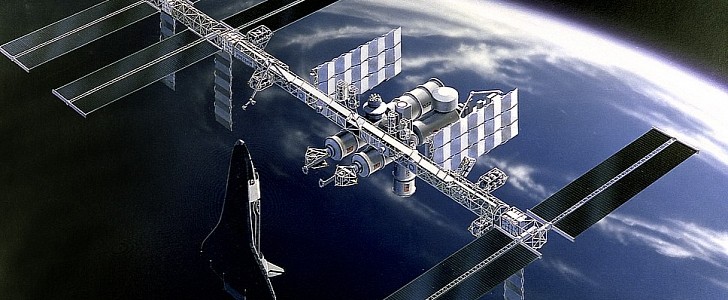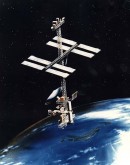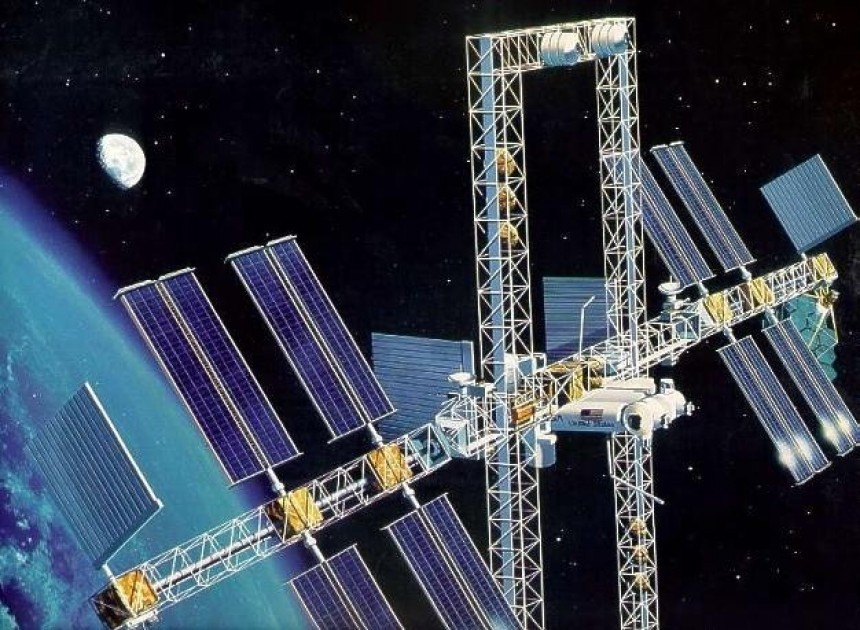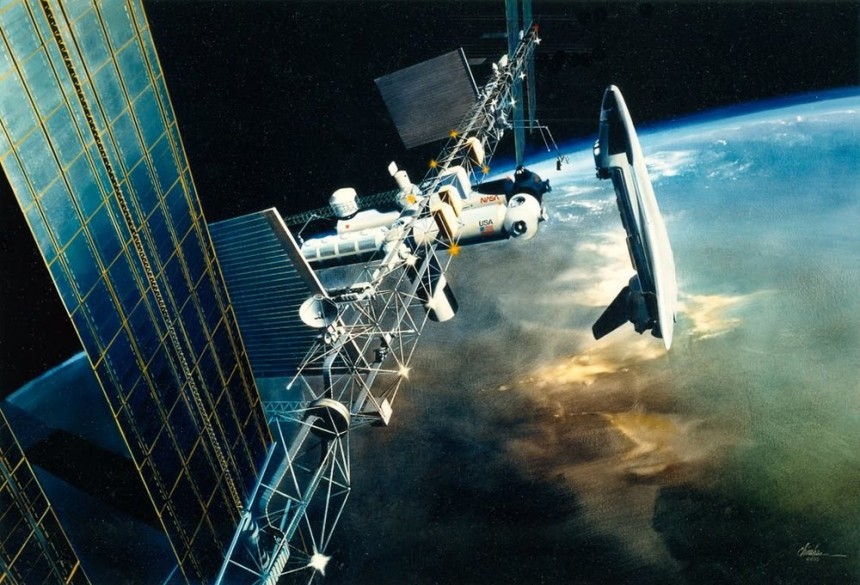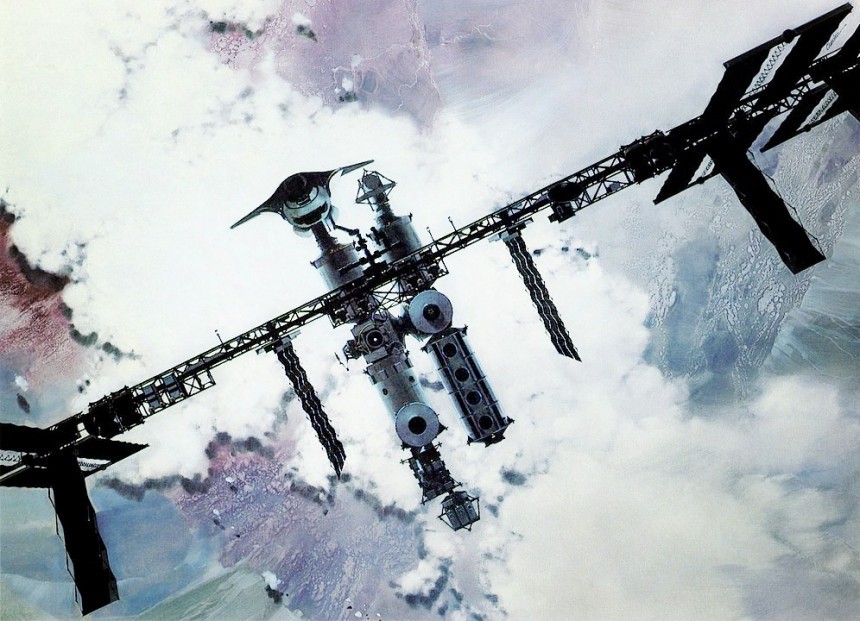Okay, here's the scoop if you haven't been paying attention. Russia decided to have a big boogaloo in Ukraine early this year, then promptly dropped their support for the International Space Station once their obliged work concludes in 2024.
Once this happens, they'll have a go at making their own space station. But before the Russians ever got involved, the ISS was a design study under a totally different project. This is the story of Space Station Freedom, the concept for a NASA/ESA collaborative space station that would have likely been launched had the Soviet Union managed to survive into the 21st century.
Space Station Freedom, or SSF, as we'll call it interchangeably, was set to be the cornerstone of NASA's manned space endeavors post-Apollo, alongside the Space Shuttle. A shining metal beacon of western dominance in aerospace during the era of Soviet stagnation in the late 70s through 1991. Although life for the average U.S. citizen was infinitely cushier than behind the crumbling Iron Curtain, the Soviets had at least one feather in their cap left.
That being, they'd beaten NASA in getting a multi-module space station into orbit. The craft in question was called Mir. It launched in 1986, and until 1994, only Cosmonauts selected by the Soviet and later the Russian government were allowed to travel to it. But even before Mir entered Low Earth Orbit, then U.S. President Ronald Reagan had already announced intentions to construct a more permanent presence in space than had been possible with the previous generation of manned orbital space stations like the Soviet Salyut and American Skylab.
In his Presidential State of the Union address in January 1984, President Reagan dedicated a portion of his speech to his space station ambitions. Such ideas were floated in the dog days of the Mercury and the Apollo programs. But they were abandoned in a full commitment to first the Apollo missions and then the multi-use Space Shuttle program. So, in a sense, the old adage about the chicken coming before the egg or vice versa is apt for the Shuttle, as it pre-existed any space station substantial enough to justify its existence.
Throughout the 80s, design concepts were created detailing how the station would, in a sense, be built around the needs of the American Space Shuttle. Starting with a peculiar-looking "Dual Keel" design that more or less resembled a giant metal rectangle in space you could mistake for a piece of New York City scaffolding. The concept consisted of two long metal trusses running parallel to each other.
These would encompass the length of the station with comms and solar arrays at either end. All pieces were joined by two shorter trusses running parallel to each other at a 90-degree angle from the lengthwise set of trusses. All joined together at the corners and made to work harmoniously. Roughly three-quarters of the way up, a central composite metal truss ran through the structure parallel to shorter the top and bottom portions. Upon this truss, a central collection of habitation modules would house astronauts from participating space agencies in the U.S. Japan, the European Union, and Canada, the last of whom agreed to build the world's most complex manipulator arm ever mounted to a spacecraft. It's a feature later adopted by the Shuttle and ISS. Shuttle docking ports would also be in this centralized location.
In a move that shouldn't surprise anybody, NASA Administration, as well as Congress, soundly rejected this engineering proposal. The rationale behind the rejection was cited as high up-front costs and a high degree of difficulty to construct. The tragic Shuttle Challenger Disaster of STS-51L in 1986 did nothing to help matters. By 1987, an entirely different path was chosen for the American space station project. Now finally given up on Space Station Freedom.
SSF's design consisted of a single truss design similar in scale and weight to what the International Space Station would ultimately become. Both Presidents Reagan and George H.W. Bush expressed public interest in the SSF project. Giving consecutive rounds of funding to the program at the end of Reagan and the beginning of Bush Sr's respective second and first terms in the late 80s and early 90s.
Ambitions of the previous two Presidents to get to the Moon by the 2000s and to Mars by the 2010s were quashed by the subsequent U.S. President Bill Clinton in a feverish and arguably foolhardy attempt at balancing the budget by all means necessary. It also called for another comprehensive rework of the SSF. In fairness, estimated costs to get the SSF up and running had already ballooned from $8 billion to over $20 billion. So, it's at least understandable why events unfolded as they did.
As it happened, further geopolitical snafus in Eastern Europe at the turn of the previous decade meant suddenly meant there was a plethora of Russian space station flight hardware designated for the never-launched Mir 2. All sitting in ex-Soviet facilities, just begging for someone to come along and send it to space. In terms of timing, it couldn't have been more perfect for NASA and Roscosmos if they had tried.
Eventually, the Russians were able to launch the first of their ex Mir-2 modules, dubbed Zarya, into LEO in November 1998. The following month, Space Shuttle Endeavor, made from spare parts left in storage following the loss of Challenger, united Zarya with the second ISS module, the Unity node, where subsequent crews would share meals and socialize with one another. The rest, as they say, was history.
It goes without saying that the ISS will never be the same when and if the Russians ever do follow through with their intentions to leave and set out on their own. With their frenemies in China already fielding a Space Station of their own, it's not hard to imagine Russia's Roscomos agency has similar ambitions of their own.
At any time other than 2022, there's a good chance Russia would be able to follow through on such a project. But for reasons that should be blatantly obvious, there are reasons to doubt they'd be able to sustain themselves in space by themselves. Only time will tell.
Space Station Freedom, or SSF, as we'll call it interchangeably, was set to be the cornerstone of NASA's manned space endeavors post-Apollo, alongside the Space Shuttle. A shining metal beacon of western dominance in aerospace during the era of Soviet stagnation in the late 70s through 1991. Although life for the average U.S. citizen was infinitely cushier than behind the crumbling Iron Curtain, the Soviets had at least one feather in their cap left.
That being, they'd beaten NASA in getting a multi-module space station into orbit. The craft in question was called Mir. It launched in 1986, and until 1994, only Cosmonauts selected by the Soviet and later the Russian government were allowed to travel to it. But even before Mir entered Low Earth Orbit, then U.S. President Ronald Reagan had already announced intentions to construct a more permanent presence in space than had been possible with the previous generation of manned orbital space stations like the Soviet Salyut and American Skylab.
In his Presidential State of the Union address in January 1984, President Reagan dedicated a portion of his speech to his space station ambitions. Such ideas were floated in the dog days of the Mercury and the Apollo programs. But they were abandoned in a full commitment to first the Apollo missions and then the multi-use Space Shuttle program. So, in a sense, the old adage about the chicken coming before the egg or vice versa is apt for the Shuttle, as it pre-existed any space station substantial enough to justify its existence.
These would encompass the length of the station with comms and solar arrays at either end. All pieces were joined by two shorter trusses running parallel to each other at a 90-degree angle from the lengthwise set of trusses. All joined together at the corners and made to work harmoniously. Roughly three-quarters of the way up, a central composite metal truss ran through the structure parallel to shorter the top and bottom portions. Upon this truss, a central collection of habitation modules would house astronauts from participating space agencies in the U.S. Japan, the European Union, and Canada, the last of whom agreed to build the world's most complex manipulator arm ever mounted to a spacecraft. It's a feature later adopted by the Shuttle and ISS. Shuttle docking ports would also be in this centralized location.
In a move that shouldn't surprise anybody, NASA Administration, as well as Congress, soundly rejected this engineering proposal. The rationale behind the rejection was cited as high up-front costs and a high degree of difficulty to construct. The tragic Shuttle Challenger Disaster of STS-51L in 1986 did nothing to help matters. By 1987, an entirely different path was chosen for the American space station project. Now finally given up on Space Station Freedom.
Ambitions of the previous two Presidents to get to the Moon by the 2000s and to Mars by the 2010s were quashed by the subsequent U.S. President Bill Clinton in a feverish and arguably foolhardy attempt at balancing the budget by all means necessary. It also called for another comprehensive rework of the SSF. In fairness, estimated costs to get the SSF up and running had already ballooned from $8 billion to over $20 billion. So, it's at least understandable why events unfolded as they did.
As it happened, further geopolitical snafus in Eastern Europe at the turn of the previous decade meant suddenly meant there was a plethora of Russian space station flight hardware designated for the never-launched Mir 2. All sitting in ex-Soviet facilities, just begging for someone to come along and send it to space. In terms of timing, it couldn't have been more perfect for NASA and Roscosmos if they had tried.
Eventually, the Russians were able to launch the first of their ex Mir-2 modules, dubbed Zarya, into LEO in November 1998. The following month, Space Shuttle Endeavor, made from spare parts left in storage following the loss of Challenger, united Zarya with the second ISS module, the Unity node, where subsequent crews would share meals and socialize with one another. The rest, as they say, was history.
At any time other than 2022, there's a good chance Russia would be able to follow through on such a project. But for reasons that should be blatantly obvious, there are reasons to doubt they'd be able to sustain themselves in space by themselves. Only time will tell.
